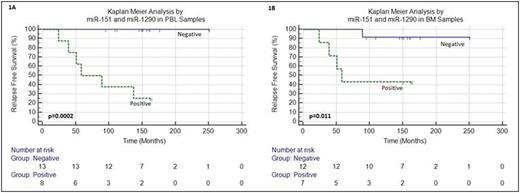Abstract
Introduction: Our previous findings showed that the microRNA (miR) expression profile of miR-151, miR-1290 and miR-451 measured in bone marrow (BM) aspirations taken at diagnosis can predict risk of relapse in pediatric acute lymphoblastic leukemia (ALL) patients treated according to BFM and DCOG protocols (Avigad et al., Genes, Chromosomes & Cancer; 55:328-339, 2016). The development of a minimally invasive blood test for predicting relapse in pediatric B-ALL patients can greatly benefit patients. Therefore, the aim of this current retrospective exploratory study was to investigate the predictive ability of miR-151-5p, miR-1290 and miR-451 measured in peripheral blood lymphocytes (PBL) at diagnosis.
Methods: BM (n=67) and PBL (n=22) samples were collected at Schneider Children's Medical Center of Israel between 1995 to 2008. Twenty cases had paired BM and PBL samples. The expression levels of miR-151-5p, miR-1290 and miR-451 were measured in both BM and PBL samples from B-ALL patients (mean age = 6.6 years, median 5.5 years, range 1.3 to 19 years) taken at diagnosis. Pearson correlation (n=20) was applied for assessing the correlation between BM and PBL following logarithmic transformation. Kaplan Meier analysis was performed for testing relapse free survival (RFS). The cutoff value used for survival analysis for each miR, was determined by the highest Youden index (J=Sensitivity + Specificity - 1).
Results: Similar to our previous study all three miRs measured in BM samples (n=67) were able to predict relapse risk (p=0.027). The expression levels measured in BM and PBL samples of all three miRs were significantly correlated (miR-151-5p, r=0.764, p<0.0001; miR-1290, r=0.725, p<0.0001; miR-451, r=0.553, p=0.011). For Kaplan Meier analysis, we defined "positive" as equal or below the cutoff for miR-151-5p or miR-451 and above the cutoff for miR-1290. In PBL samples, only miR-151-5p (p=0.002) and miR-1290 (p=0.004) maintained their prognostic significance. When combining those two miRs, patients who had positive expression levels in PBL of at least one miR had significantly lower RFS of 25% vs. 100% in the negative patients (p=0.0002, Figure 1A). Similarly, the paired BM samples maintained significant inferior RFS of 43% vs. 92% in the negative patients (p=0.011, Figure 1B).
Conclusions: Expression levels of miR-151 and miR-1290 in PBL are useful for predicting relapse risk. Results from this exploratory investigation established the feasibility for continuing research and performing a larger prospective clinical trial using blood samples. Moreover, we will investigate the utility of the miRs for long-term monitoring of B-ALL patients during follow-up. The development of a blood test based on miR-151 and miR-1290 for monitoring B-ALL patients risk for relapse will be pursued in parallel to the development of the bone marrow test. These findings should be interpreted with caution due to the small cohort size.
Partly supported by Curewize Health Ltd.
Avigad:Curewize Health: Consultancy, Patents & Royalties: Patent Applicant of Curewize IP. Shichrur:Curewize Health: Employment, Patents & Royalties: Patent Applicant of Curewize IP. Dotan:Curewize Health: Employment, Other: Options Holder in Curewize Health. Yarden:Curewize Health: Employment, Equity Ownership. Yaniv:Curewize Health: Consultancy, Patents & Royalties: Patent Applicant of Curewize IP.
Author notes
Asterisk with author names denotes non-ASH members.


This feature is available to Subscribers Only
Sign In or Create an Account Close Modal